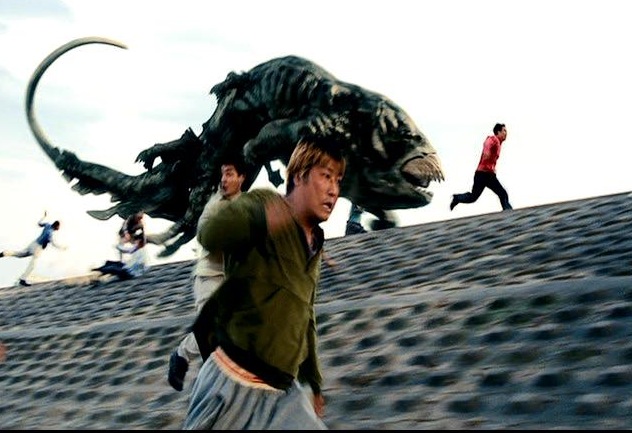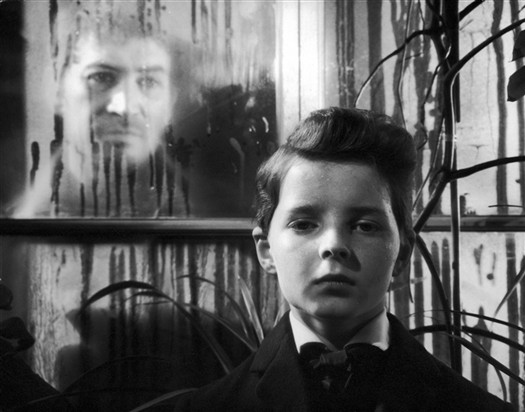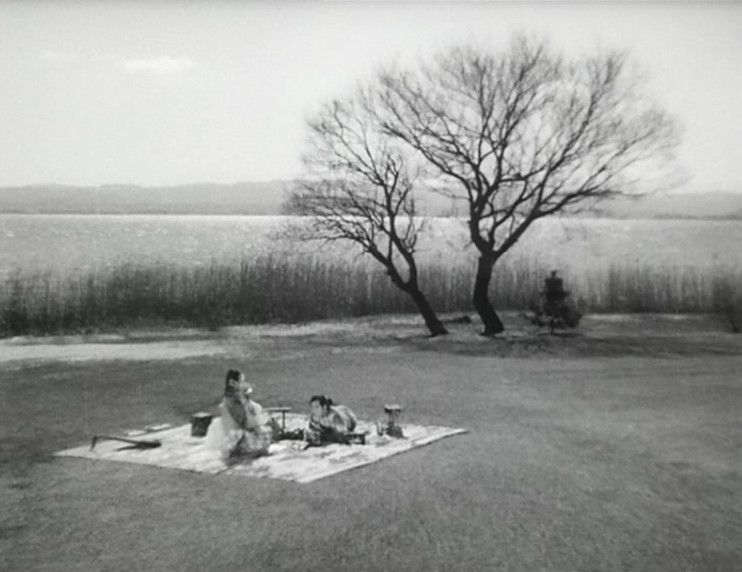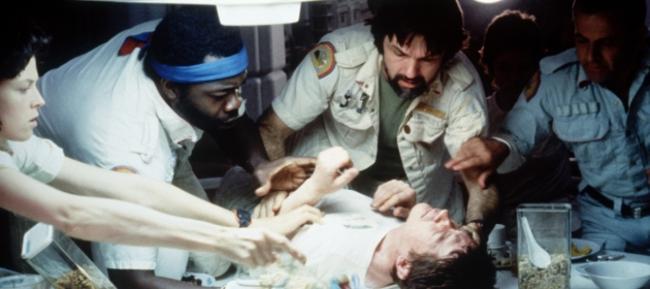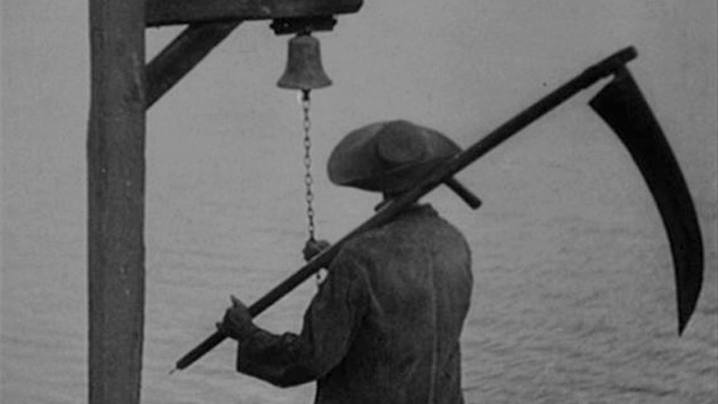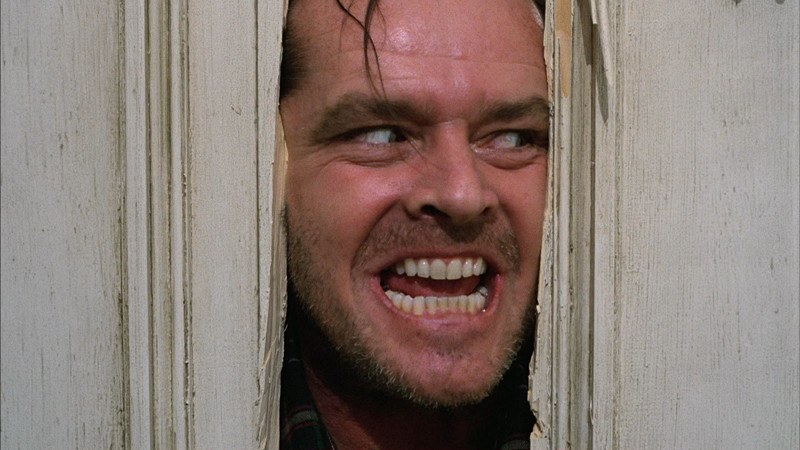7. The Host (Bong Joon-ho)
A dark but cheeky Korean horror film, The Host is social commentary and an affecting family drama masquerading as monster movie. No worries though – the film does give us plenty of monster action as its lizard-like behemoth beast ravages the public on multiple occasions.
But it’s the slowly-building dread of the film’s pessimist vision of government action, the increasingly desperate antics of a father to save his child, and the nervous, tense sewer sequences brought to life by unfairly talented Bong Joon-ho that give this movie its grit and nuanced edge.
This is a film that manages to both attempt a lot and do everything it attempts well, and perhaps the rare film that can unite the spectrum of horror lovers.
A number of other South Korean films released in the past decade or so, from Joon-ho’s own mesmerizing descent into madness Memories of Murder and his later gloomy, blackly humorous alternative detective story Mother (both of which maintain his off-kilter humor and cavalier social observation), to colleague Kim Jee-woon’s violent, complex study of revenge I Saw the Devil, are equally chilling, and some are even superior films, but The Host is the purest horror of the bunch and gives the genre a great kick in the rear.
6. Jaws (Steven Spielberg)
Jaws set the stage for one of the most fruitful and successful popular directorial careers in history, and, you know, there is that whole thing about scaring thousands of people from ever swimming at the beach again.
And, yes, it is horrifying – Spielberg brings a slowly-building, ravaged dread to the film as he modulates the direction through quick cutting and longer takes while also playing with perspective and giving us a number of bravura sequences that play like inspired chaos, filled with all manner of directorial flourishes and jarring, pointedly monotonous music. Many are techniques he’s used to birth suspense before and after, but he never went for outright horror again.
Most surprising of all, however, is Spielberg’s trio of central characters, who spend the film coming to terms with each other as much as the titular shark. They serve Spielberg’s larger examination of class dynamics and American masculinity.
The three – Chief Martin Brody (Roy Scheider), Quint (Robert Shaw), and Matt Hooper (Richard Dreyfuss) – reflect middle-class, working-class, and upper-class respectively, and all find themselves forced together at uneasy angles. They are tightened and suffocated by Spielberg’s direction, which draws out the cramped chaos of the boat as much as the empty open-ness of the ocean.
Despite its famed violence, the core of the film is also deeply humanist, and Spielberg develops the three protagonists as walking piles of cognitive dissonance torn between obsession and resistant frailty, consumed by conceptions of masculinity they are forced to remain compliant with. The film’s best scene does not feature a shark, but merely these three comparing old wounds in a display of male bonding so wryly snarky as to induce tears.
5. The Innocents (Jack Clayton)
Jack Clayton directed this British haunt around the same time as American Ray Wise interspersed his two biggest musical hits with an equally gallows auteur-horror, The Haunting. Both have similar themes about power and control found in the mental consciousness of cramped spaces and the ever-present past of the present. But far more important is how both go for broke stylistically.
In some ways, The Innocents is even more deranged than its American counter-part. It’s sound in particular is unparalleled, with a song so decrepit and sickly it threatens to fall apart with every note and the downright ear-shatteringly loudest, most scathing banshee-shrills you’ve ever heard (the key word with the film is gothic – it’s positively refute with big, grandly ominous gestures like the screams).
For all the audio aplomb, though, the visuals match – the camera flips and flops around like a beached madman, moving between deep focus explorations of wide, idyllic landscapes rendered like empty, cavernous wounds in the earth, and piercing, pervasive, painful close-ups. Added to this is the lighting which varies from intentionally minimalist to pointedly focused, and some extremely fine superimposition work, with characters sitting on top of others and threatening to swallow them whole.
And if all of this wasn’t enough, the stunningly theatrical, supremely smarmy performances, especially by the deranged children a governess (Deborah Kerr) takes care of and comes to believe are possessed, remind less of reality than quintessentially British theater.
This is a perfect fit to the self-consciously theatrical bent of the film, the sense of “unreality” permeating the whole affair and sticking to the characters’ put-on flesh with ease. They play less like people than puppets with skin stretched uneasily over a semblance of personality – it’s painfully queasy, as is the film. That’s quite a bag of tricks, and Clayton knows how to use them.
4. Ugetsu (Kenji Mizoguchi)
If Kurosawa was a story-teller and Ozu a painter, Kenji Mizoguchi was a fable-maker. A director of physical space abstracted to pure emotions even as they were rendered hazily, enigmatically concrete on screen, he pioneered the use of elegiac long takes, refusing to cut to capture characters as individuals.
He instead chose to follow rather than to find, giving us characters in relation to each other and their environment. And what he found was an environment that allowed them to live but which also suffocates them, massaging out their internal flaws and realizing what lies within them to reflect it back onto the human gaze.
Usually, of course, he did this with horrific drama – look no further than Sansho the Bailiff. But Ugetsu is dramatic horror, far more interested in ethereal atmosphere and mood. Most of all though, it’s a poetic exploration of pure dreamlike haze, capturing not the swaggering grandiosity of a Kurosawa or the pinpoint, piercing penetration of an Ozu, but a more free-flowing sense of “feeling” as it wafts and breathes and expands.
Many horrors demand to be noticed. Mizoguchi preferred to imply. In this capacity, Ugetsu is at odd angles with most any other horror film ever released. His cavernously wide shots capture a profound emptiness, of miniscule people struggling with problems that define their lives and seem big to them – they’re crushed under the weight of their own insignificance.
The film does not give us the great respite of any film – event, or “things happening” – we have none of that here, and we are forced instead to come to terms with perpetual emptiness. Describing Ugetsu as a horror film is a strange claim, and yet the film meets the one main qualification with gusto: it is horrifying. It is nothing short of cinema’s greatest dreamlike nightmare.
3. Alien (Ridley Scott)
Arriving in 1979, Ridley Scott’s caustic, lonely Alien was the perfect melding of the decade it ended with the decade that would soon begin anew. On one hand, it is very much a 70’s American New Wave film, with a sense of social decay, paranoia, terse and angry stylistic showmanship, and an undercurrent of working class desperation.
On the other, it’s a sci-fi film, coming out on the heels of Star Wars and the explosion of genre film-making in the popular consciousness. Of course, if the world in 1979 was expecting another Star Wars with Alien, then Scott has a few choice words for them.
Alien is the story of seven space explorers (space truckers is more like it) who encounter the vast loneliness of space only to realize it’s slightly less lonely than they had expected. It swaps out one fear, that of perpetual emptiness, for another, the more simple kind, of a monster running around and killing people. And, crushingly, we realize there’s no real difference between the two.
For his part, Scott uses shadow and intercuts between brutal long-take and even more harrowing quick montage work to stop and start the film at irregular, unnerving intervals. The film’s sound design, meanwhile, is stunning, intermixing lashing, quick-cut noise that stirs the soul with some of the finest, most chilling silence to be found in genre film-making.
Scott’s film remains a spine-tingling sci-fi horror wholly at odds with the cheeky, campy space-adventure films quickly taking over the cinemas around this time, a blood-curdling caterwauling wail that few other sci-fi films even dared answer.
2. Vampyr (Carl Theodor Dreyer)
Carl Theodor Dreyer’s 1932 tone-poem of hazy malaise is the rare film with no true predecessor or approximate. It’s heavily indebted to German expressionism, but it replaces angular extremes and the heightened difference between black and white with a barely-there haze that threatens to sap black, white, or any image, of meaning.
Dreyer’s film, with a plot largely defined by “a man walks around a town and observes strange happenings”, marries aspects of expressionism to a deeply impressionist mise-en-scene, not to mention the director’s famed dramatic use of piercing close-ups that threaten to scratch the celluloid itself. It lacks any true approximate in the human world, playing less like a finished film than an afterimage of an alien work, a dream within which we move in and out and glimpse partial layers of reality rather than anything full or cohesive.
Dreyer intentionally shot every image through a layer of gauze in an attempt give the film a transparent aura, as though it was not so much made as witnessed and forgotten. As such, it’s a deeply sickly film, constantly threatening to fade away on a moment’s notice.
1. The Shining (Stanley Kubrick)
This adaptation of Stephen King’s novel about a struggling writer’s descent into madness while serving as a caretaker at a seemingly abandoned hotel is less notable for its narrative than the magisterial way in which director Stanley Kubrick tells it. Perhaps no film is a better example of his determined, clinical craft than his foray into horror, a reflection of how his style was a sure fit for instilling pure chilly despair in the hearts and minds of an unsuspecting audience.
Kubrick’s penchant for long-takes is put to the test here, as he intentionally weaves in an out of the cavernous hotel while pointedly failing to give us any sense of the place at all – it remains, until the end, a nightmarish mystery of the mind, a wonderful set of limitations. His steely precision, clockwork decay, and formalism begs this is the work of an artist and thus causes us to put the whole film’s validity into question.
Meanwhile, Kubrick’s famous icy intellectualism is a perfect fit for the haunted, snow-covered atmosphere of the film. Perhaps he saw a little of himself in the Overlook Hotel, an object that delights in causing human destruction just as he did as a director, a connection explored further in considering how Kubrick forced shots over and over again to monotonously instill dread and weary despair in his actors and crew, forcing them to live the lives of their characters as best he could.
He wanted to trap them in his lens, his gaze, like the hotel was to do. And the film he built around the hotel, perhaps as a present to its madness and his own, is clinical horror at its finest.
Author Bio: Jake Walters is a recent graduate of Amherst College and an aspiring film-writer/ist. He shares his thoughts on film at his website, thelongtake.net and is particularly interested in film in relation to society, race, class, and gender, He writes frequently on horror films and looks to Werner Herzog, Michel Foucault, and John Shaft for life advice. You can find him on Twitter@long_take.
